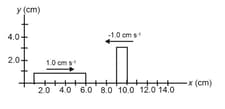Principle of Superposition
Important Questions on Principle of Superposition
Two pulses travelling in opposite directions along a string are shown for in the figure. Plot the shape of the string at and , respectively.
Two sinusoidal waves combining in a medium are described by the equations
and
where is in and is in . Determine the maximum displacement of the medium at
(a)
(b) and
(c)
(d) Find the three smallest values of corresponding to antinodes.
A wave pulse on a string has the dimensions shown in figure. The wave speed is .
(a) If point is a fixed end, draw the resultant wave on the string at and .
(b) Repeat part (a) for the case in which is a free end.
Two transverse waves and superimpose to produce a node at . If the equation of wave is , then the equation of wave is
Two identical harmonic pulses traveling in opposite directions in a taut string approach each other. At the instant when they completely overlap, the total energy of the string will be
Sources separated by vibrate according to the equation and They send out waves along a rod with speed . What is the equation of motion of a particle from the first source and from the second, are in ?
Incident wave is reflected by an obstacle at which reduces intensity of reflected wave by Due to superposition, the resulting wave consists of a standing wave and a travelling wave given by where and c are positive constants.
Position of second antinode is
Incident wave is reflected by an obstacle at which reduces intensity of reflected wave by Due to superposition, the resulting wave consists of a standing wave and a travelling wave given by where and c are positive constants.
Value of is
Two waves and superimpose to produce a stationary wave, then
A man generates a symmetrical pulse in a string by moving his hand up and down. At , the point in his hand moves downwards from the mean position. The pulse travels with speed on the string and his hand passes times in each second from the mean position. Then, the point on the string at a distance will reach its upper extreme first time at
Three one-dimensional mechanical waves in an elastic medium is given as,
are superimposed with each other. The maximum displacement (amplitude) of the medium particle would be




